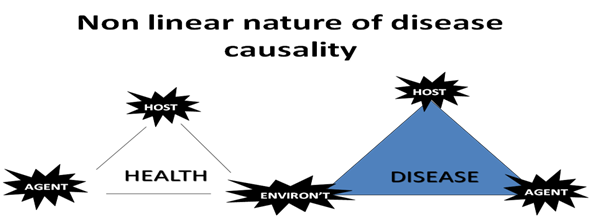 Abstract: The scientists from all around the world have been curious about the subject of genesis of diseases since the beginning of time. There have been multiple theories and views about the same. The author has discussed Hahnemann’s view and ontological theory and has provided evidences to prove them.
Abstract: The scientists from all around the world have been curious about the subject of genesis of diseases since the beginning of time. There have been multiple theories and views about the same. The author has discussed Hahnemann’s view and ontological theory and has provided evidences to prove them.
Introduction: Life (in Sanskrit: jive means soul) has a principle of unity-in-diversity. Diseases are as old as the life on planet Earth, which is about 4 billion years old. Life presents itself in various formats in plant and animal kingdom and has been showing diseases too. We have been trying to understand the genesis of disease by way of various understandings and experiences to remedy them. This led to origination of various theories to explain the genesis of disease. The theories indicate towards the remedy and still only a few are able to remedy per se. Why and how these many numbers of theories have cropped up? Which is the fundamental one? To know this, one has to delve deep into the history of mankind and medicine.
History: The illuminating light of enlightened Eastern world entered into the Western world in the 2nd millennium BC. But courtesy to political dynamism, this flame of light could not sustain. Finally in the 1st millennium AD, the Dark Age prevailed around the globe for 1500 years! It was only Arab and Asia, which were holding the torch of light. Era for the development of new medicine (homoeopathy) had begun. Auras of Pythagoras, Hippocrates, and many other vitalists have worked for the new development. In the late 18th century, the young Samuel Hahnemann rebelled against the misguided notions of the new rationalists in the world of medicine. In the study of history of medicine, Master Hahnemann understood the Western version of Vedic medicine envisioned by Pythagoras and established by Hippocrates. Parallel to the above, Cnidian School of Ionians and Post-Hippocratic legacy misled the humanity by their erroneous and incomplete concepts. This was furthered more due to political crisis here and there around the world. Finally many number of Schools of Thought in medicine emerged (Hahnemann named them theoretic medicine in his book, Organon of Medicine, Aphorism 1, footnote 1) explaining the genesis of disease. On this, final icing was done by René Descartes. And in this conflict of holism vs rationalism, the holistic concept of medicine gone buried deep! It was only the blessed Hahnemann who dug this truth out by paying the toll alone for the suffering sighing humanity. He finally established that medical art deals with the life. And the principles of life must be of its own and not based on principles of physics and chemistry.
Keeping the above history in mind, let us try to understand the genesis of disease.
Genesis of Disease: Before knowing this, one must understand the definition of disease, wherein the genesis is explained.
- For long, medicine has been dominated by ontological theories of disease: Theories in which diseases had existence independent or separate from the suffering organism. The naive question “Where do diseases come from?” actually reflects this popular error. But,
- Hahnemann (1755–1843) said that the greatest number of diseases were of dynamic (spiritual) origin and nature. Their cause is therefore, not perceptible to the senses.
Despite the enormous variety in mechanisms, most can be understood with the definition of disease as “Reactions of the organism to, and/or a failure to cope with, some unbalancing change in their ‘internal environment’ [Claude Bernard’s (1813–1878) milieu interieur]”.
Hahnemann’s concept was confirmed in the late 19th century by Rudolf Virchow (1821–1902) declaring that “diseases have no independent or isolated existence; they are not autonomous organisms, not being invading a body, nor parasites growing on it; they are only the manifestations of life processes under altered conditions”.
In 20th century, number of scientists came up with the systemic view of life (holistic way) which says, “Living organisms can be seen as systems that are in a state of dynamic equilibrium not with their external environment but internally. To survive, they must continuously exchange energy and matter with their external environment, while keeping the composition of their milieu interieur stable within narrowly defined limits. They adjust to changes in their internal environment through a variety of homoeostatic mechanisms, such as behavioural responses, immune reactions, and detoxification procedures”. According to this view, disease results when changes in the internal environment temporarily or permanently exceed the capacity for adjustment of the organism, or when a defect in the adjustment mechanism leads to an inadequate response. So, we know that Hahnemann’s concept of disease is now well taken unanimously.
As per Master Hahnemann, the animating component of organism, i.e. Vital Principle, is responsible for the health and disease of the organism. So, it is the derangement of vital principle that causes a disease. He has mentioned in aphorism 11, “When a person falls ill, it is only this spiritual, self acting (automatic) vital force, everywhere present in his organism, that is primarily deranged by the dynamic influence upon it of a morbific agent inimical to life; it is only the vital force, deranged to such an abnormal state, that can furnish the organism with its disagreeable sensations, and incline it to the irregular processes which we call disease; for, as a power invisible in itself, and only cognisable by its effects on the organism, its morbid derangement only makes itself known by the manifestation of disease in the sensations and functions of those parts of the organism exposed to the senses of the observer and physician, that is, by morbid symptoms, and in no other way can it make itself known”.
Dynamic Influence: This is very well explained in the triad given below.

Having known this dynamic genesis of disease, what would be the way of treatment then? This has been very well put by James Krauss, in his introduction to sixth edition of Organon of Medicine as, “It is impossible to know all the antecedents’ causative of disease consequents. Tolle causam is easier said than done. How, then, shall we remove or palliate these effects by medical substances? Here, Hahnemann steps in to say, for the first time in all history: Remove the effects and you remove the disease, the cause of the effects. Cessat effectus cessat causa”. Hence, this needs to know the anamnesis of disease (evolution of disease). Hahnemann taught the way of knowing the Psycho-Patho-Bio-Graphy of the patients.
It will not be out of place to quote the words of distinguished geneticist Theodosius Dobzhansky, “Nothing in biology makes sense except in the light of evolution”. Evolutionary biology is, of course, the scientific foundation for all biology, and biology is the foundation for all medicine. To a surprising degree, however, evolutionary biology is just now being recognised as a basic medical science. The enterprise of studying medical problems in an evolutionary context has been termed Darwinian medicine. Most medical research tries to explain the causes of an individual’s disease and seeks therapies to cure or relieve deleterious conditions. These efforts are traditionally based on consideration of proximate issues, the straightforward study of the body’s anatomic and physiological mechanisms as they currently exist. In contrast, Darwinian medicine asks why the body is designed in a way that makes us all vulnerable to problems like cancer, atherosclerosis, depression and choking. Thus, offering a broader context in which to conduct research.
The evolutionary explanations for the body’s flaws fall into surprisingly few categories:
- First, some discomforting conditions, such as pain, fever, cough, vomiting and anxiety, are actually neither diseases nor design defects but rather are evolved defenses.
- Second, conflicts with other organisms– Escherichia coli or crocodiles, for instance- are a fact of life.
- Third, some circumstances, such as the ready availability of dietary fats, are so recent that natural selection has not yet had a chance to deal with them.
- Fourth, the body may fall victim to trade offs between a trait’s benefits and its costs; a textbook example is the sickle cell gene, which also protects against malaria. Finally, the process of natural selection is constrained in ways that leave us with suboptimal design features, as in the case of the mammalian eye.
Conclusion: Master Hahnemann, in his works, had put the truth which is as per the ancient golden era and has even got confirmation from now-a-days research. He explained the genesis of diseases in such a way which leads to cure of diseases and having no conflict with any branch of science. Let us follow him and serve the suffering, sighing humanity to cure—Mission of physicians.





